Dilemma Thinking
Tutorial
Why Dilemmas?
Riding the Bull: the necessity of incompatibles!
In embarking on making change, especially transformational change towards a radical goal, we inevitably plunge into conflicts, contradictions and oppositional polarities. When you experience two mutually conflicting values or goals you may be experiencing either a choice or a dilemma. If it is truly a choice situation then you can weigh alternatives and decide. But if the situation is a dilemma it is something different that needs different tools and treatment. A dilemma treated as choice can have disastrous consequences!
If a dilemma is not tackled consciously it can paralyse action, stifle creativity and diminish motivation and goodwill as the forces conflict with each other. Often the dilemma gets polarised into two warring schools of thought as two sides seek to convince each other of the value of their singular perspective. Rather than choosing we need to seek resolution in which both values are brought together into a new, innovative solution. In this process it is essential to depart from either/or thinking towards a both/and creative resolution that integrates all the best ideas.
Charles Hampden-Turner developed an approach that he called dilemma thinking as a technique for successful navigation of these ambiguous messy situations. He realised that some (but not all) aspects of such situations can be seen and defined as dilemmas. We will define the nature of a dilemma later but for now let’s consider a colloquial example. “You can’t have your cake and eat it” is familiar folk wisdom. We use it to describe situations which seem clearly to be either/or. From a dilemma perspective there are some situations which seem like that but where it is actually not only possible, but necessary to have your cake and eat it, for example we must pay attention to short term imperatives, but also adapt to changing conditions. But there is a price. It requires a process of accommodating assumptions other than your own; it involves being prepared to learn and be creative; and, in in terms of tension between groups it needs collaboration. Resolving a dilemma is a creative process in which you may find yourself changing some of your views about the way the world works. You will find yourself riding a bull – holding the horns of the dilemma!
Faced with a challenge or a task in such circumstances it is necessary to find a way of transforming the situation. Effective transformational strategy requires creative resolution rather than evasion of the critical dilemmas that show up. A critical dilemma is a polarity or tension between two equally necessary values which are themselves seemingly incompatible. In a dilemma choosing one or the other does not work.
The pattern of dilemmas
Very often in a dilemma you will discover one of the conflicting values is the based around sustaining an existing performance value that is deeply ingrained and well measured. It is rock-like in two respects. It is considered to be the foundation of success. It is also strongly protected and immovable. You will discover the other main conflicting values to be based around change which is somewhat dynamic and unpredictable. This is like a whirlpool in two senses. It is considered to be the essential dynamic that can keep pace with or stay ahead of a changing environment. It is also rather hard to grasp hold of and uncertain to predict.
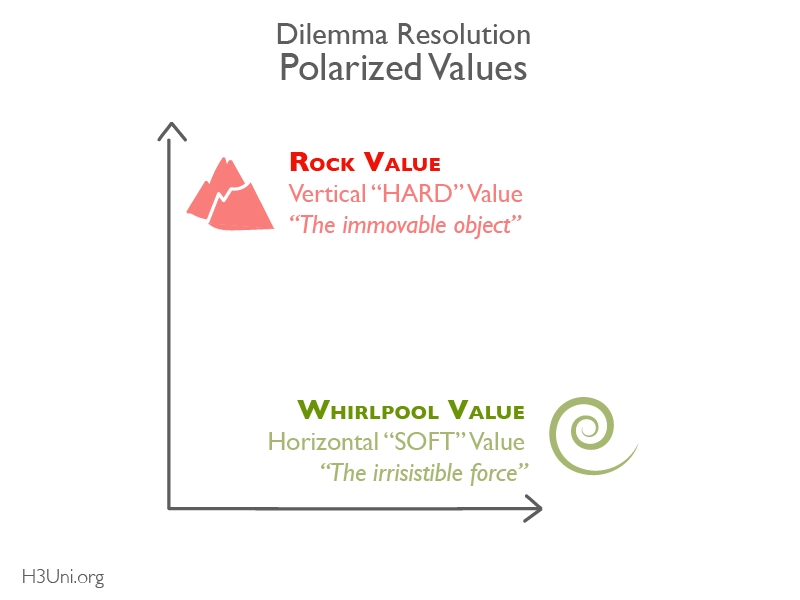
In a genuine dilemma there is an entanglement between the two values and their associated situations because the dilemma itself is a manifestation of a deeper structure. In fact, the underlying structure is a systemic one in which unseen feedback loops create unexpected consequences. If the advocates of rock values “win” (that is dominate) then at some point in the future the feedback from the whirlpool realities will catch up and cause defeat. If advocates of the whirlpool values prevail then sooner or later the rock realities will catch up and cause defeat. Pursuit of short term profit alone exhausts the assets of a company. Pursuit of growth alone leads to profit collapse.
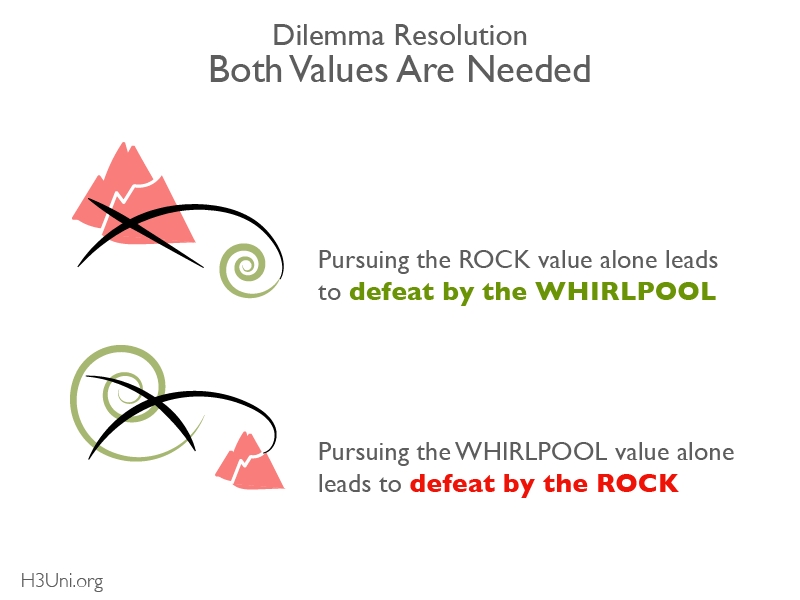
A simple summary is that if the advocates of one value get what they want in the short term they don’t get what they want in the long term.
Dilemmas are alive and never still. Wherever the balance is at a given time there are forces of change at work. To ride the bull we need to understand the five zones of a dilemma.
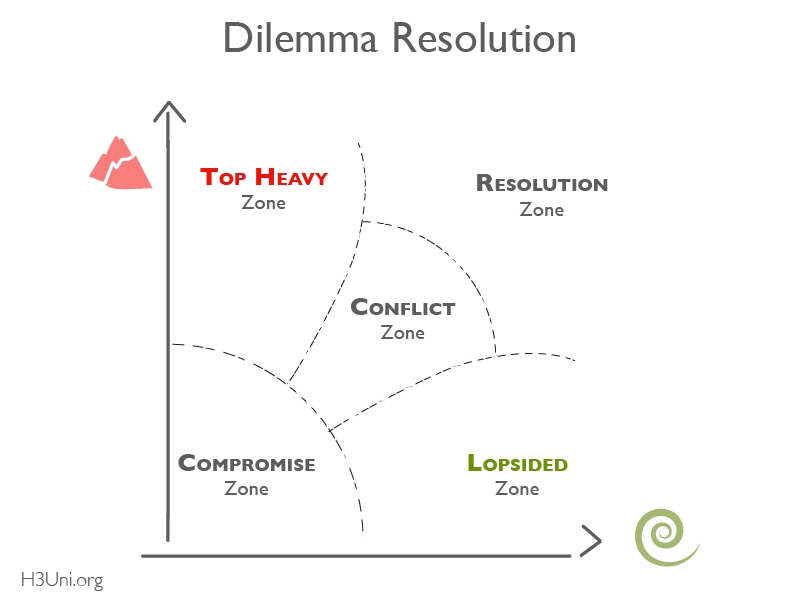
These are:
THE COMPROMISE ZONE: This is where the tendency is to avoid the dilemma, even deny its existence, and accept a diluted compromise in which actually neither value dimension gets pursued. The result is a downward or degenerative spiral. Competitors who resolve the dilemma win hands down.
THE TOP HEAVY ZONE: This is where the rock values dominate and seem to be satisfied. However the seeds of collapse are in the neglect or rejection of the whirlpool values.
THE LOP SIDED ZONE: As a mirror of top-heavy, this is where the whirlpool values dominate and seem to be satisfied. However the seeds of collapse are in the neglect or rejection of the rock values.
THE CONFLICT ZONE: This where both values are strongly expressed in the situation but are unable to reach any creative resolution. Indeed it is a war for supremacy of either rock or whirlpool. The conflict may be protracted (in which case it wastes resources on internal friction), destructive (in which case it flips to Top Heavy, Lop Sided or Compromise). In these cases, the outcomes are as above. The conflict may also be creative in which case it becomes a driver for innovation and learning which enables the creation of a whole new situation.
THE RESOLUTION ZONE: This is where both values are expressed even more strongly but in a way in which they learn to collaborate and mutually support each other. We get “the best of both worlds”. We have learned to ride the bull and are now benefiting from its tremendous energy.
To help fix the structure in our mind we consider some symbols. The symbol for rock value and for whirlpool value have already been introduced. The compromise zone is represented by a descending arrow to remind us that compromise is not static but dynamically degrading. If we evade the conflict zone by compromise we are caught in a vicious spiral. The conflict zone in the centre is represented by an explosion.
The creative resolution zone is represented by an ancient Eastern symbol sometimes called the two fishes. The idea is that both values are in balance supported by a quality of the opposite. Another way to think about this is like figure/ground as in the psychology of perception. A creative resolution is often with one value horn in the foreground and the other in the background, but both together essential for the whole scene.
The dynamics of dilemma resolution
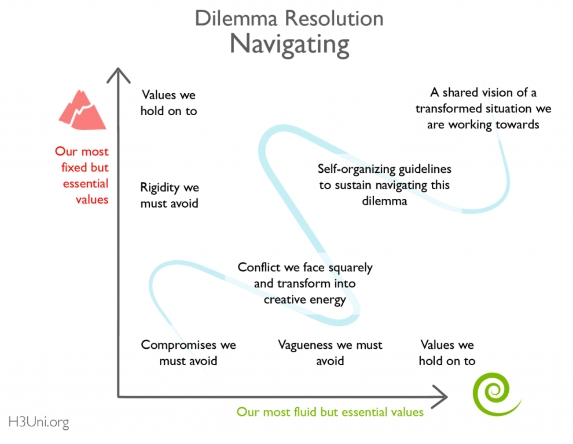
The challenge in resolving a dilemma is to avoid all four unproductive positions: compromise / top heavy / lop-sided / conflict. This creative synthesis or resolution requires:
Mutual accommodation
Figure /ground dialogue
Creative thinking and design
Facing the conflict zone and deriving power rather than friction from it
We can switch from the metaphor of riding the bull to one of sailing a boat. This also brings out the fact that a dilemma is dynamic. To navigate the boat to a destination we have to take into account the wind and tide which are constantly changing. The process of resolving a dilemma is cybernetic, that is it needs continuous steering based on feedback. Just like sailing to a destination into the wind, the dilemma resolution is a process of tacking to and for to make the best headway despite the buffeting of wind and current.
Four ways to fail, one to succeed
So five futures are possible in a dilemma situation. Only one of them ensures creative resolution and synthesis, illustrated here with a typical business dilemma.
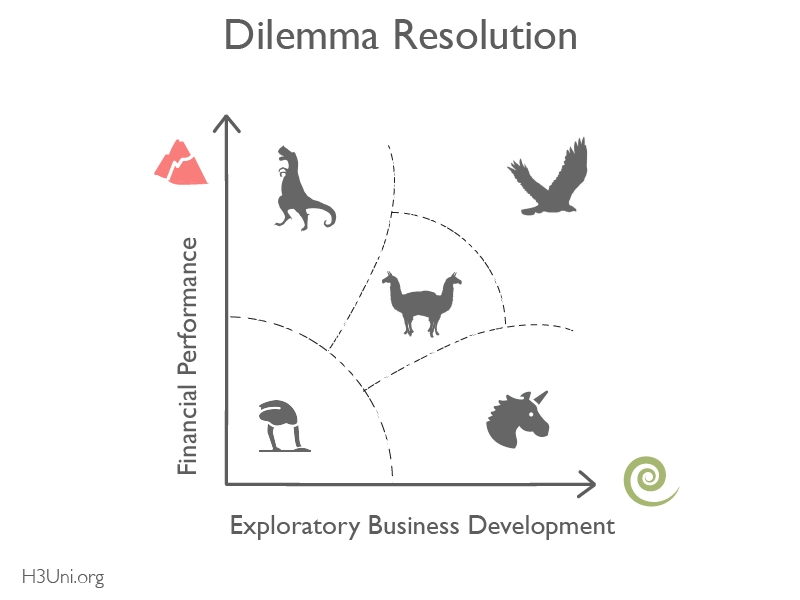
The four failure modes are:
Tight rock value management alone will be successful for a while but eventually bring on extinction (Dinosaur trap).
Pursuit of the whirlpool value will be equally disastrous (Unicorn trap).
Getting caught in perpetual argument will sooner or later implode the situation (Push-me-pull-you trap).
Burying the dilemma issues behind defensive routines, keeping the issues undiscussable and assuming it will all be OK will inevitably lead to decline. Once things unravel that can be very quick (Ostrich trap).
The success mode is:
To resolve the dilemma with transformative innovation (flight of the eagle).
The eight steps to dilemma resolution
The dilemma grid maps out a dilemma space. The process of resolving a dilemma requires covering thus space in a dynamic sequence. The eight steps below chart the process that is most likely to succeed in getting people arriving together at the resolution zone. (This was developed by Charles-Hampden-Turner)
This is the guidance task of the facilitator. It is shown on the diagram here.

Viewing the dilemma diagram as a grid with the values on each axis, we can use this to plot where we believe we are in the midst of a dilemma. For example, 1:2 would be compromise; 5:5 would be maximum tension; 1:7 would be top heavy and 7:1 would be lop sided. 8:8 would be strong resolution.
Following the sailing analogy, the process of resolving a dilemma is like a combination of charting, navigating and steering. The eight main stages of dilemma resolution are:
1 SURFACING What is the situation that is challenging the organisation?
2 CHARACTERISING What are the characteristic polarities, tensions and schisms which are appearing?
3 FORMULATING What are the underlying values which are polarised and as either/or that needs treating as both/and?
4 INTENSIFYING What are the consequences of pursuing a single value in extremis?
5 FRAMING How do these extremes look when re-framed as figure/ground, text and content?
6 INNOVATING What learning is generated by incorporating both values in a generative 1+1 = 3 resolution?
7 WAVING How might such a goal be navigated as a waving oscillation between the two values?
8 SYNERGISING What vicious and virtuous spirals emerge in combination with other related primary dilemmas?
Psychological Tips for Facilitating Dilemmas
The most challenging aspect of facilitating dilemma resolution is the dominant tendency in the unreflective mind to polarise issues into right/wrong, for/against and superior/inferior. When caught in a genuine dilemma this inevitably leads to contradiction and conflict. So the task of the facilitator is to set the mood for and encourage the group to be in a reflective state in which fixed assumptions can be gently challenged and some space loosened up for considering other perspectives. This is the generic problem of shifting from mindset to perspective.
This shift is greatly helped if you, the facilitator, are able to be in a reflective state about the issue in question, listen carefully to the different viewpoints and, at least initially, give them all equal credibility. The point here is that the successful resolution of a dilemma will inevitably require some flexibility and accommodation on the part of all viewpoints. However, it is worth reviewing the psychology of the four failure positions in the dilemma space.
Compromise zone: This can range from rejection that there is even a dilemma (sweeping the issue under the carpet) to finding some pseudo-solution that seems to work but is superficial and inevitably will come unstuck.
Top-heavy zone: This is evident if the values of the more fixed horn of the dilemma dominate usually through a powerful, though questionable, logic and persuasion which rejects the other horn as fluffy, intangible and impractical.
Lop-sided zone: This is evident if the values of the more fluid horn of the dilemma dominate either through a strong energy to overthrow any fixity or through ungrounded enthusiasm.
Conflict zone: this is evident when holders of the different values are essentially in an argument as to which view is superior, more realistic and more practical. In its milder form it leads to endless debate, a process which cannot resolve dilemmas. It does not have the potential for transformative innovation. In its stronger form it is outright conflict where neither value holders will give up their position and they are of roughly equal strength so there can be no winner.
With this background the psychology of the success zone can be seen, as in a mirror, as a reflective and creative shared space in which:
the dilemma issue is being squarely faced
the more fixed values are able to be flexed
the more fluid values are able to pause
the two contrasting or contradictory values are both strongly held in a way that does not get overwhelmed by emotional conflict and where integrity and inner harmony are sought through creative insights and ideas.
Exercise
It is good to practice Generative Thinking a number of times since like any skilled practice that combines intellectual discipline with intuition and imagination it requires repeated application to get the hang of it, especially if you are going to facilitate others in the technique.
For facilitation of groups the idonic form of the hexagon is a powerful visual support for ‘1+1=3’ type thinking. It also helps share the process in a group. The form suggested in the Dilemma Mapping Guide is:
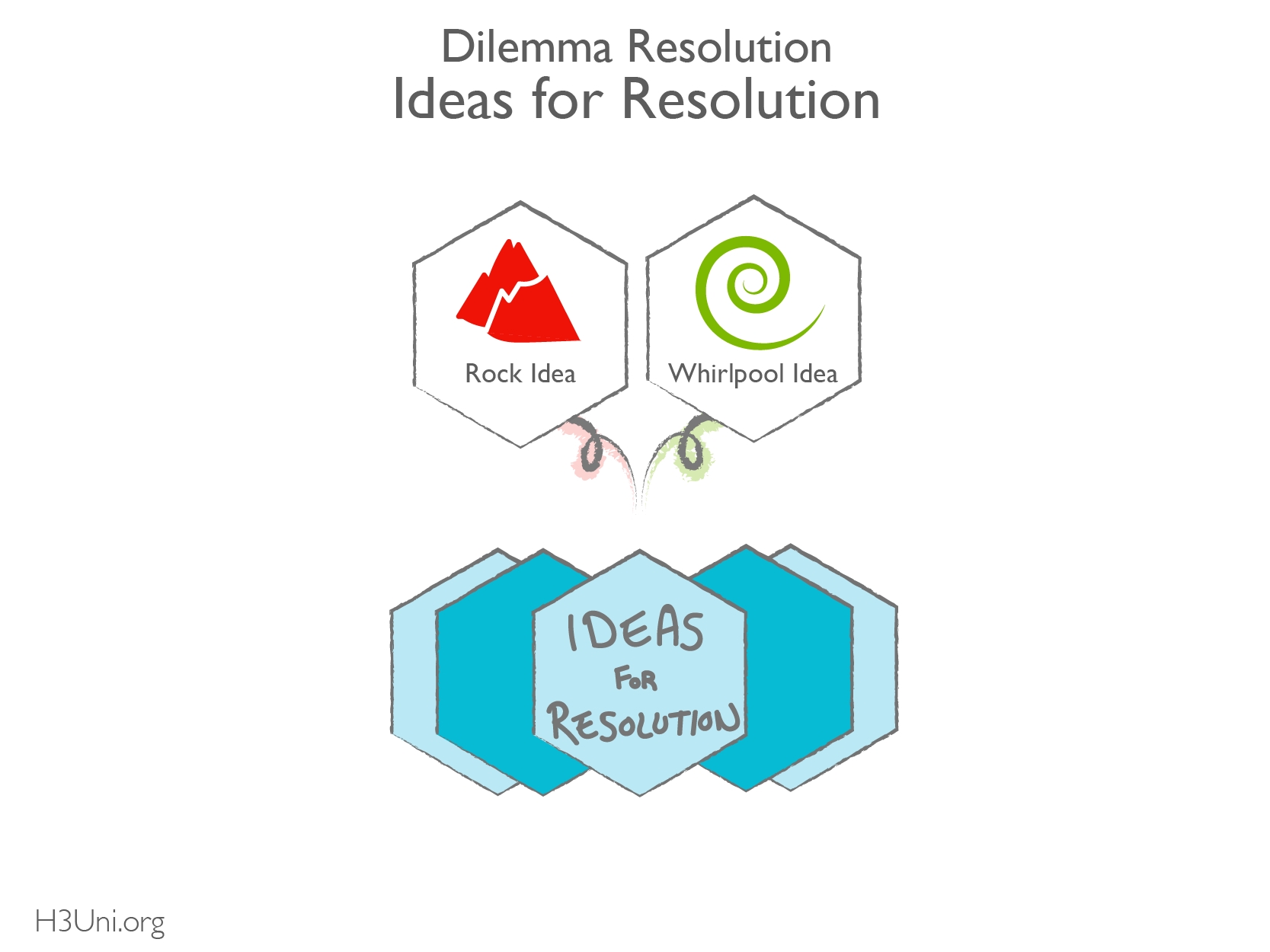
Here is an exercise form to practice this further. The process is to set up dilemma pairs and use them to provoke innovative ideas for resolution.
Set up a sample dilemma using the dilemma axes. There should be a ‘rock’ axis and a ‘whirlpool’ axis. Some generic examples you can use directly or use to shape your own dilemma are:
ROCK——————–WHIRLPOOL
financial security — entrepreneurial risk
strict morality — compassion and forgiveness
precise engineering — scope for adaptation
Whatever your practice dilemma, write down 3 or 4 requirements for each contradictory dimension
Write a rock requirement in the left blue hexagon and a whirlpool requirement in the right green hexagon. Note you can print multiple copies of the diagram for writing each exercise on.
Hold both ideas in mind treating the blank yellow hexagon as a space for new ideas that might resolve the dilemma. Approach this in adventurous ‘what if?’ mood.
When you have repeated this several times with different pairings, review the resolution ideas (yellow) you have generated and evaluate them for potential.
Note: a good resolution idea will incorporate both values evenly and yet also go beyond them to something new. This provides a stepping stone to transformative innovation.
Methods
Dilemma Navigation is the general method for using dilemma thinking on its own or within any other H3Uni Method.
As well as application in general situations, this has a specific use in Three Horizons (see Three Horizons Mapping) to frame H2 as a dilemma between H1 and H3 in order to construct possibilities for H2+ innovations, and in conjunction with Navigational Scenarios (coming soon) to support a continuous action-learning cycle in the face of uncertainty as the project moves into H3.
See also the guide in the IFF Three Horizons Kit which has a dilemma method for Three Horizons action planning.
Creative Commons Attribution-ShareAlike 4.0 International (CC BY-SA 4.0) license framework.
Attribution-ShareAlike 4.0 International (CC BY-SA 4.0) license framework.### How to Use this License
CC BY-BY-SA
This license allows reusers to distribute, remix, adapt, and build upon the material in any medium or format, so long as attribution is given to the creator. The license allows for commercial use. If you remix, adapt, or build upon the material, you must license the modified material under identical terms.
Read about Open Access to H3Uni Methods and Materials
View License Deed | View Legal Code
Was this helpful?